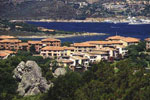 Olbia was founded by the Carthaginians about VI Century B.C.; nevertheless, this area has been inhabited since the VIII Century B.C. Right from the beginning, the harbour represented its main resource, especially because of its corn export industry which has constituted its main source of revenue.
Olbia was founded by the Carthaginians about VI Century B.C.; nevertheless, this area has been inhabited since the VIII Century B.C. Right from the beginning, the harbour represented its main resource, especially because of its corn export industry which has constituted its main source of revenue.The name "Olbia" means a "happy town" (città felice), even though the city's past has been quite difficult. Olbia was destroyed and reconstructed several times throughout its history. This may also account for the loss of its original name, which was finally regained in 1939.
During the 60's, Olbia experienced a real demographical boom and extensive tourism development.
Nowadays, the population is over 50 000 and the city’s surface is bigger than the city of Sassari - the capital of province. This expansion has been achieved partially thanks to Olbia's harbour, which has become the most important port for passengers in Italy, also thanks to its international airport.
The city counts significant monuments such as the ex Cathedral, situated in the old town and dedicated to St. Simplicio, bishop of Olbia martyred under the Diocletian Emperor in the III century A.D. The church was built in three different phases from the XI and the XII Centuries and over a Roman Necropolis, the remains of which are still visible inside the church (i.e. memorial tablets).
Olbia has also become famous because of the recent archaeological discovery of 24 ship wrecks - 2 of them from the age of Nero and 16 from the V century A.D. The remaining 6 come from the Judicial period. The wrecks were found during the construction of the road's new tunnel.
Only few kilometres from Olbia is the Pedres Castle (Castello di Pedes). Its style of construction comes from the Judicial period of the Visconti in Gallura. Another castle, Castello di Sa Paulazza, is situated on the small hill and is of Byzantine origin. It's square-shaped and has 4 corner towers in the area where an antique Nuraghe rose in the period when Emperor Giustiniano conquered Sardinia in 534 A.D. The stones from Nuraghe were used for the construction of the castle.
Olbia, thus, cannot be considered just as a stopover for tourists coming to Sardinia, it is also a town rich in attractions.

